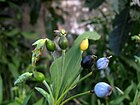Note: This is a project under development. The articles on this wiki are just being initiated and broadly incomplete. You can Help creating new pages.
Coix lachryma jobi - Gavedhuka
Gavedhuka is a perennial or annual grass found in India. It is widely distributed throughout the plains and warm slopes of hills upto 1500 m.
Contents
- 1 Uses
- 2 Parts Used
- 3 Chemical Composition
- 4 Common names
- 5 Properties
- 6 Habit
- 7 Identification
- 8 List of Ayurvedic medicine in which the herb is used
- 9 Where to get the saplings
- 10 Mode of Propagation
- 11 How to plant/cultivate
- 12 Commonly seen growing in areas
- 13 Photo Gallery
- 14 References
- 15 External Links
Uses
Gastrointestinal problem, Lung cancers, Abdominal tumours, Oesophageal, Cure warts, Lung abscess, Lobar pneumonia, Appendicitis, Rheumatoid arthritis, Beriberi, Diarrhoea, Oedema.
Parts Used
Chemical Composition
Benzoxazolinones, amino acids (leucine, tyrosine, histadin, arginine and coicin). The seeds contain trans-ferulyl stigmastanol and titoleic and vaccerans-ferulyl campestanol. Seeds contain coixenolides, a mixed ester of palmnic acids.[1]
Common names
| Language | Common name |
|---|---|
| Kannada | Manjutti |
| Hindi | Kasai, Garheduaa, Garahedu, Gargari |
| Malayalam | Kaatugotampu, Kaakkappalunku |
| Tamil | Kaattukuntumani |
| Telugu | Adaviguruginja |
| Marathi | NA |
| Gujarathi | NA |
| Punjabi | NA |
| Kashmiri | NA |
| Sanskrit | Gavedhu, Gavedhuka |
| English | Adlay, Jobs tears |
Properties
Reference: Dravya - Substance, Rasa - Taste, Guna - Qualities, Veerya - Potency, Vipaka - Post-digesion effect, Karma - Pharmacological activity, Prabhava - Therepeutics.
Dravya
Rasa
Kaṭu, Madhura
Guna
Rūkṣa, Laghu
Veerya
Śīta
Vipaka
Kaṭu
Karma
Kaphahara, Pittahara, Mūtrala, Kārśnya
Prabhava
Habit
Identification
Leaf
| Kind | Shape | Feature |
|---|---|---|
| Paripinnate | Oblong | Leaf Arrangementis Alternate-spiral |
Flower
| Type | Size | Color and composition | Stamen | More information |
|---|---|---|---|---|
| Unisexual | 2-4cm long | Pink | Flowering throughout the year and In terminal and/or axillary pseudoracemes |
Fruit
| Type | Size | Mass | Appearance | Seeds | More information |
|---|---|---|---|---|---|
| Oblong pod | Thinly septate, pilose, wrinkled | Seeds upto 5 | Fruiting throughout the year |
Other features
List of Ayurvedic medicine in which the herb is used
- Viṣṇu Taila
Where to get the saplings
Mode of Propagation
How to plant/cultivate
Job's Tears grows best in the moister areas of the tropics, succeeding at elevations up to 2,000 metres.[3]
Commonly seen growing in areas
Wet places in grassland, Himalayas, Open sunny places.
Photo Gallery
References
- ↑ The Ayuredic Pharmacopoeia of India Part-1, Volume-5, Page no-14
- ↑ [Morphology]
- ↑ Cultivation detail
External Links
- Ayurvedic Herbs known to be helpful to treat Gastrointestinal problem
- Ayurvedic Herbs known to be helpful to treat Lung cancers
- Ayurvedic Herbs known to be helpful to treat Abdominal tumours
- Ayurvedic Herbs known to be helpful to treat Oesophageal
- Ayurvedic Herbs known to be helpful to treat Cure warts
- Ayurvedic Herbs known to be helpful to treat Lung abscess
- Ayurvedic Herbs known to be helpful to treat Lobar pneumonia
- Ayurvedic Herbs known to be helpful to treat Appendicitis
- Ayurvedic Herbs known to be helpful to treat Rheumatoid arthritis
- Ayurvedic Herbs known to be helpful to treat Beriberi
- Ayurvedic Herbs known to be helpful to treat Diarrhoea
- Ayurvedic Herbs known to be helpful to treat Oedema
- Herbs with Seeds used in medicine
- Herbs with common name in Kannada
- Herbs with common name in Hindi
- Herbs with common name in Malayalam
- Herbs with common name in Tamil
- Herbs with common name in Telugu
- Herbs with common name in Sanskrit
- Herbs with common name in English
- Habit - Perennial shrub
- Index of Plants which can be propagated by Seeds
- Index of Plants which can be propagated by Cuttings
- Herbs that are commonly seen in the region of Wet places in grassland
- Herbs that are commonly seen in the region of Himalayas
- Herbs that are commonly seen in the region of Open sunny places
- Herbs
- Poaceae





